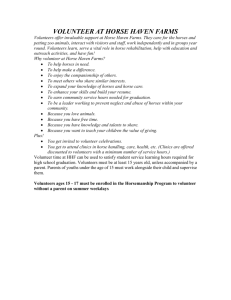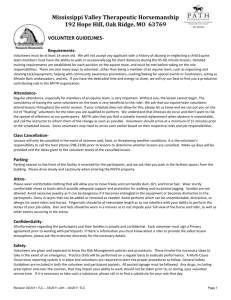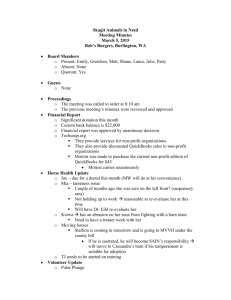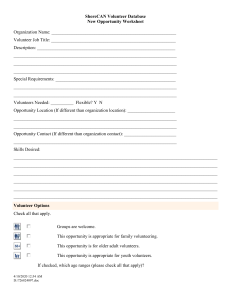Volunteer Orientation and Training
advertisement
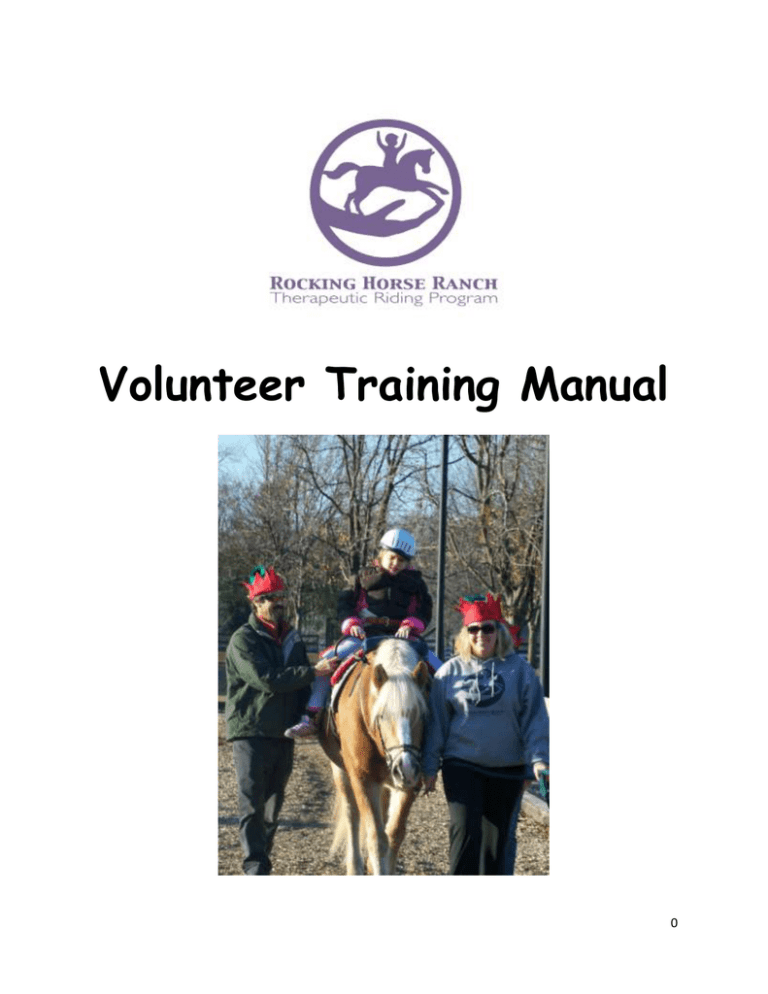
Volunteer Training Manual 0 Table of Contents Welcome …………………………………………………………………………………………………………………………………………… 2 Contact Information ………………………………………………………………………………………………………………………….. 3 Programs …………………………………………………………………………………………………………………………………………… 4 Volunteer Checklist …………………………………………………………………………………………………………………………… 5 Volunteer Job Descriptions ……………………………………………………………………………………………………………….. 6 Volunteer Incentive Program …………………………………………………………………………………………………………….. 8 Volunteer Guide Lines ……………………………………………………………………………………………………………………….. 9 Rules …………………………………………………………………………………………………………………………………………………. 12 Risk Management …………………………………………………………………………………………………………………………….. 13 1 Welcome to Rocking Horse Ranch Therapeutic Riding Program Thank you for choosing to volunteer with us at Rocking Horse Ranch (RHR)! Volunteers are a crucial to the success of our program. We would not be able to provide these programs to our clients without you, and we rely on you to help our program operate as safely as possible. We hope your experience at RHR will bring you fulfillment. You are a valuable asset to us. Thank you for all that you will do for us! Welcome to the RHR team, and we hope that you enjoy the time that you get to spend with us at the farm. If you every have any questions please don’t hesitate to ask, and we are always open to your suggestions / comments. About the Program: RHR was founded in 1991 by Maury Frieman and Eileen VanHouten after years of research and planning. For 12 years, RHR operated part time at Rock Springs Equestrian Center, where Phil and Martha Flowers generously donated the use of their facility. Starting in the fall of 2003, thanks to the generous support of Matt and Flonnie Boykin, the Blue Banks Homeowners Association, and the Pitt Memorial Hospital Foundation, RHR moved to Blue Banks Farm, which we are in the process of purchasing while we operate it as a facility dedicated exclusively to therapeutic riding. Our goal is to provide equine assisted activities and therapy for children and adults with physical, cognitive, or psychological disabilities from Greenville and the surrounding area. While students pay a small fee, if financially able, THT operates primarily on donations, and the time and efforts of our dedicated volunteers, who are the backbone of our program. There are a variety of roles for our volunteers to fill, and we look forward to having you on the RHR team. Our Mission: The ultimate goal of the program is to improve each rider's quality of life so that they can become more independent, productive and active members of the community. About PATH Intl.: PATH International (PATH Intl.) was founded in 1969 as the North America Riding for the Handicapped Association (NARHA) to encourage best practices in the field of Equine Assisted Activities and Therapies (EAAT) through accreditation, instructor certification, and networking. PATH Intl. consists of over 850 member centers worldwide. Through these programs more than 40,000 individuals with disabilities benefit from activities, which include therapeutic riding, equine assisted psychotherapy and learning, carriage driving, interactive vaulting, and competition. 2 Contact Information Rocking Horse Ranch 1721 Blue Banks Farm Rd. Greenville, NC 27834 (252)752-0153 www.RHRNC.com www.Facebook.com/RHRNC Executive Director Malaika Albrecht infor@rhrnc.com Volunteer Coordinator Ashlyn Batten volunteer.coordinator.rhrnc@gmail.com Educational Coordinator Kristina Cudney, MS, LRT/CTRS educational.coordinator.rhrnc@gmail.com Barn Manager Sherri Moore barnmanagerrhrnc@gmail.com 3 Programs we offer Rocking Horse Ranch is dedicated to providing a variety of Equine-Assisted Activity (EAA) programs for both children and adults with disabilities. These are our current programs: Therapeutic Riding - PATH Intl. certified therapeutic riding instructors conduct lessons to teach adapted riding skills. The rider receives cognitive, physical, and emotional benefits in addition to learning how to ride with the goal of maximum independence. Physical benefits of therapeutic riding include improved muscle tone, balance, posture, coordination, and motor development. Therapeutic riding offers sport, recreational, and educational benefits while promoting emotional and psychological well-being, confidence, and communication skills. Equine-facilitated learning (EFL) - EFL is an educational approach to equine-assisted activities. EFL content is developed and organized by credentialed practitioners with the primary intent to facilitate personal growth and development of life skills through equine interactions. Equine-facilitated psychotherapy (EFP) – EFP is defined as an interactive process in which a licensed mental health professional working with or as an appropriately credentialed equine professional, partners with suitable equine(s) to address psychotherapy goals set forth by the mental health professional and the client. Interactive Vaulting (IV) – IV is an activity in which the students preform gymnastic type movements that can be very simple such as sitting without holding on to the surcingle or a more elaborate compulsory move such as kneeling or standing on the horse. IV fosters teamwork, teaches respect for the horse, fosters independence, builds confidence, encourages social interaction, offers individualized instruction when mounted, and it introduces all gaits in a short period of time. 4 Volunteer Program Information Volunteer Checklist All volunteers must be at least 14 years old. Ages 14-15 can help with barn related volunteering, 16 and up can be lesson volunteers. No exceptions to this policy are possible. Volunteers are expected to show commitment, punctuality, and respect the confidentiality of our clients. Volunteers need to be available for a minimum of 1 hour per week for the entire session. Sessions are typically 10-12 weeks long. Volunteer assignments are based on availability, interest, and experience. Volunteer forms must be completed and returned to RHR. Volunteer must sign up for a general volunteer orientation and training. Volunteer must read volunteer manual and take manual test. Volunteer must attend the general volunteer orientation and training. Volunteers must attend the volunteer training provided by RHR for a specialty program if the volunteer is with that program (EFL/EFP and IV). Volunteering involves physical activity. Make sure that you are comfortable with the role that you are selecting to volunteer for. Volunteers must be able to take directions and work independently with them. Volunteers must have a positive attitude and be able to adapt to change and be flexible. Volunteers must have the ability to follow directions and take instruction. Volunteers must adhere to our privacy policy at all times. Volunteer Orientation and Training RHR provides Volunteer Orientation and Training session for all new volunteers. There is one schedule before each lesson session. For these dates check the program’s website and/or Facebook page. At this orientation session volunteers will be introduced to the staff and be given a barn tour. We will go over how to sidewalk with a student as well as have leader tryouts. Informational handouts are available on the website, and volunteers are encouraged to check out any volunteer incentive classes offered at the program. 5 Volunteer Job Descriptions Lesson Program Volunteers: To assist with lessons, volunteers must be able to walk for an hour on uneven surfaces and jog short distances. Volunteers are expected to follow all guidelines as identified in this manual. Horse Leaders are responsible for the care of the horse before, during, and after the lesson. Therefore, they should arrive at least 20 minutes prior to the start of the lesson and anticipate staying 15 minutes afterward. This includes tacking and warming up prior to the start of each lesson (a lot of the horses in our program are older and need the extra time to get moving before students get on). The horse leader’s main responsibility during lessons is the horse. If the leader notices something going on with the horse, they should notify the instructor immediately. After the lesson, horse leaders bring the horse back in the barn, untack and groom if needed. Volunteers who wish to serve as horse leaders must attend and pass a Horse Leader Training/Orientation. Prior to becoming a horse leader, the person should have competent knowledge of and experience with working with horses. Being a horse leader requires understanding equine behavior and demonstrating strong horse handling skills. Volunteers with little or no previous horse experience may attend volunteer classes to work toward gaining the skills and experience necessary for this role. Please refer to the Horse Leader Training handout for more information. Sidewalkers walk beside the horse in lessons and provide physical and/or emotional support to the rider while performing a form of a hold. Sidewalkers must be able to hold their arm above shoulder height and walk for a minimum of 30 minutes. Please refer to the Sidewalker Training handout for more information about this role. Horse Buddy: All of the horses at RHR enjoy getting some extra time being loved on and groomed. Horse buddies are scheduled to a specific horse in the barn that they will get to come out to see once a week to groom, love on and take for a (led) walk in the field. The horses do look forward to these times so it is just as important as the other volunteer roles. (Please note: horse buddy time are only available during the day when there are no lessons going on.) Barn Helpers: Barn helpers work with the barn staff to help with barn chores. Duties included are feeding, grooming, horse care, cleaning stalls and other barn chores. This is a way to get to be around the horses and help them as much as they help our students. Maintenance Volunteers: Volunteers will work with our maintenance staff to help with general maintenance, repairs and improvements of the facility. Office Volunteers: Volunteers can help at the receptionist desk by answering the phone and checking in students for their lessons. 6 Fundraising Volunteers: Help with our big fundraising events or help with coming up with fundraising ideas. 7 Volunteer Incentive Program This is a 10-12 week curriculum that allows learning opportunities for volunteers to practice a specific skill they have questions about and for new volunteers to learn the policies and procedures we follow here at Rocking Horse Ranch. The classes are limited to 8 people per week. We assign people on a first call/sign-up, first serve basis. Once the limit of 8 people is reached, the class will be full for that week. Every week will be a new topic. The topics focus on things that you may encountered at the center such as horse leading, round penning, lunging, equine massage, long lining and horse behaviors. For the class schedule see the barn manger. 8 Volunteer Guidelines, Procedures and Policies Be Punctual: The riders depend on you; a class cannot start without all of the assigned volunteers present. If you will be absent from a class that you are scheduled to work, please let us know as far in advance as possible so that we can find a replacement volunteer for you. You can leave a note on the message board, or you can mark out the week you will he away on the volunteer time sheet, or you can call the barn phone (752-0153) and leave a message in advance. Volunteers who miss 3 classes without notice will be replaced. Volunteer Sign In/Out: When arriving at the barn, check the day’s schedule at the receptionist desk in waiting room. Make sure you go to the volunteer station in the barn aisle and get your name tag. At the end of your volunteering session, return your name tag to the volunteer station and put your volunteer hours down on the sign out sheet. Please be sure to log in the time that you have worked that day. The date will be for the Monday of each week. This is our way of keeping records on our volunteers and of recording the number of horses volunteered to the program. You can also use that sheet to note absences in advance for future lesson dates. Please allow up to 5 business days to fulfill a request for a record of service or written letter of recommendation. Lesson Cancellations: In the event that a lesson is cancelled due to bad weather, rider cancellations, or other circumstances, we will make every attempt to notify volunteers at least an hour in advance to your scheduled lesson(s). If you are unsure if lessons will be going on or not please don’t hesitate to call the farm office (752-0153) to check before coming out. If lessons are cancelled then there will be a message on the greeting of our voice mail informing this information as well. Volunteer Commitment: Without our volunteers, we would not be able to run this program. You are a critical part of this process so, when you miss a lesson we have to be able to find someone to take your place as the lesson cannot go on without someone. Our horses, riders and staff depend on you and your attendance to the safety and success of the lessons. We ask that you make a commitment for a minimum of 1 hour per week (same time and day) for the length of the semester so that the 9 riders have consistency. Volunteers who miss 3 unexcused lessons without notice will be replaced. Volunteer Scheduling: Volunteer assignments and schedules are based on interest, experience, and availability. Volunteers will be contacted by the volunteer coordinator before the start of each semester to schedule your slots. Returning volunteers are given first choices for the volunteer spots and then we fill in with the new volunteers from that session’s training day to complete the schedule. The lesson schedule may change slightly from semester to semester, causing a change in horses, riders, and staff that are scheduled at a given time. We appreciate your flexibility and willingness to adapt to such changes. If you are not able to make the every week commitment to the schedule, you can be added to a sub list to be called when a volunteer is sick and cannot come in. Confidentiality Policy: All information about the participants at RHR including: riders, volunteers, and personnel will remain confidential. This information may include, but is not limited to, any medical, social, referral, personal, and/or financial information. Information concerning students will be shared with volunteers on a need to know basis. Volunteers must seek staff and rider/guardian permission prior to taking any pictures or videos. If granted permission to take photos, you must have the rider/guardian sign a photo release. Questions: If you are ever unclear about what you are supposed to be doing, what your role is, or your responsibilities, please don’t hesitate to talk to an instructor or the volunteer coordinator. Your instructor will be happy to answer appropriate questions about your particular rider and the goals for his/her lessons at a convenient time (not during the lesson or in front of your rider)….Please remember that it is important to respect the confidentiality of our riders with respect to any information that the instructor shares with you. Name Tags: Name tags are located at the volunteer station in the barn aisle. There are different colored labels on the tags depending on the role of the volunteer. Yellow – Leaders Pink – Sidewalkers Orange – Vaulting Green- EFL/EFP Red – Barn Help Purple – Horse Buddy Blue – Intern 10 Appropriate Clothing: Dress appropriately for the temperature but please avoid very loose clothing that might catch on something or startle the horse by flapping about. All volunteers must wear sturdy shoes or boots. Horses have been known to step on toes accidentally. No low cut or revealing tops or short shorts. No dangling earnings / necklaces. The only thing allowed is post earrings and a watch. No perfumes or heavy scented body lotions. It can bother many of the participant’s allergies. If you are interested in RHR logo gear, please ask a staff member. Additional Policies Please respect all off-limit areas. We love having visitors at the farm. These visits must be scheduled and guided by a staff member. All accidents must be reported immediately to staff members. Please do not do a volunteer role that you have not been trained for or are not comfortable with. 11 Rules Facility Rules NO SMOKING anywhere on the property All gates are to remain closed unless otherwise told Tool shed, turnout pastures and lofts are out of bounds for volunteers Barn Rules Everyone signs a release of liability Appropriate footwear should be worn at all times Unused equipment and prompts should be returned to their proper places Only approved horse leaders, barn volunteers and staff are to go pass red line in barn aisle Horse Rules No treats are to be given to horses at any time without direct permission of staff If you see a horse that is injured or acting abnormal notify staff immediately Horses must be groomed in cross ties or safely tied in stalls Horses must be tacked up in cross ties or safely tied in stalls NO cleaning stalls or interacting with horses in stalls while loose 12 Risk Management Volunteers are responsible for knowing and following all safety rules, emergency policies and procedures as indicated, supporting all efforts to promote safe working conditions, making full use of safety equipment, immediately reporting any unsafe working conditions or behaviors, and knowing the location of first aid kits, fire extinguishers, emergency exits and emergency plans. Emergency Dismount During riding sessions, the instructor performs rider mounts and dismounts. However, in certain situations, the instructor may ask volunteers to perform an emergency dismount. For a detailed description of emergency dismount procedures, please refer to the Horse Leader Training or Sidewalker training sections. Fallen Riders, Medical Emergencies, Accidents, & Injuries A RHR Instructor on Duty must be notified of any injury or medical emergency occurring on the property. The Instructor is responsible for managing the emergency including evaluating the scene, determining if additional medical assistance is required, and providing any first aid required. Designated volunteers may be asked to assist by retrieving a first aid kit, calling for emergency medical assistance (911). An accident report must be completed by the instructor and involved individuals for every 13 accident. Blank accident report forms can be found in the file cabinet under the helmet shelves. Completed reports should be left on the desk of the Program Director for review. Calling for Emergency Medical Assistance In the event of an emergency, volunteers may be asked to call 911. They may use a personal cell phone, the telephone located on the wall by the volunteer Station, in the waiting room beside the door going into the barn, or in the main office. Emergency call information is posted near each telephone. Emergency Procedures Policies and procedures are put in place and expected to be followed for the safety and well-being of participants, staff, volunteers and guests of any and all RHR programs. When working with horses, as much as we care and love them, a human’s life must ALWAYS come first. It is of utmost importance to remain calm, reassure riders, and take direction for RHR staff and instructors. RHR staff is responsible for managing the emergency and applying any first aid required. Volunteers may be called upon to assist. Location of First Aid Kits Human First-Aid Kits In the barn aisle near waiting room door In waiting room, in locker labeled “Human First Aid” Horse First-Aid Kit In Feed Room Fire Procedure A Staff Member may extinguish fire with fire extinguisher if the fire is smaller than an office trash can. Locations of Fire Extinguishers Main Barn (3) – In front of Sonnie’s stall, In front of Shavings room and next to feed room. Hay loft (1) – on stair case in loft Storage loft (1) – on stair case in loft If the fire cannot be extinguished without the assistance of emergency personnel, an Instructor will call 911 and notify individuals on site that a fire is in progress. 14 All persons will evacuate and congregate in front field. No one should leave until an instructor indicates it is safe to do so. Instructor will take head count of volunteers and students. Equine Procedures Horses will be evacuated by Instructors / Barn Staff to fields away from danger providing that it is safe to do so. Lesson Procedures Riders will be dismounted and returned to their parents or caregiver and go to designated area out of harm’s way. Instructors will direct volunteers to remove equipment/untack horses and the instructor will turn out in field away from danger. Equipment may remain where it is. All persons will congregate in Front field. Tornado, Hurricane, or Severe Thunderstorm Procedure Instructors are responsible for monitoring the weather forecast for the farm. If a severe weather advisory has been announced or there is an imminent threat, all lessons will be cancelled and volunteers will be advised NOT to come to the farm if there is sufficient time to do so and the following procedure will take place: Any person that arrives at the farm or is already present will be asked to leave if it is safe to travel. Riders will be dismounted and remain with their parent or caregiver in a designated safe area. Instructors will direct volunteers to untack horses and return them to a safe place, such as their stall. Equipment can be left safely out of the way. Barn Staff members / Instructors will tend to the horses. Horses will be untacked and provided with a safe place, such as their stall, with plenty of water and supply of hay. Stall doors and windows will be closed with at least one window cracked for ventilation No one should enter stalls for any reason. Lights and electrical equipment should be turned off and unplugged. The large barn doors should be closed. Humans should seek safety in bathroom until the threat has passed. Riding helmets can be worn if needed. 15 GLOSSARY OF PHYSICAL AND COGNITIVE DISABILITIES The following are brief, non-medical descriptions of some disabilities and conditions of participants one might encounter in a therapeutic riding setting. This is not intended as a comprehensive explanation of a specific disability. Rather it is a general overview with an explanation of how therapeutic riding can be beneficial. Arthritis: Inflammatory disease of the joints. Types: Osteo, rheumatoid and juvenile rheumatoid. Characteristics: Pain; lack of mobility; loss of strength. Benefits of therapeutic riding: Gentle rhythmic movements to promote joint mobility and to relieve pain; increase strength. Autism & Pervasive Development Disorder (PDD): A broad spectrum of disorders ranging from mild to severe, which affects thought, perceptions and attention. Characteristics: Impairments in social interaction and communication; restricted and repetitive patterns of behavior, interests and activities; impairments in the use of nonverbal behaviors such as eye to eye gaze and facial expressions; lack of social or emotional reciprocity; delays in, or lack of the development of spoken language; impairments in ability to initiate or sustain conversations with others; abnormal responses to senses such as sight, hearing, touch, balance, smell, taste, reaction to pain; deficits in gross and fine motor skills. Benefits: Provides sensory input and promotes sensory integration. Promotes communication skills (expressive and receptive). Develops strength, coordination, muscle tone and gross and fine motor skills. Promotes socialization. Cerebral Palsy: Brain damage occurring before, at or shortly after birth. It is a non-progressive motor disorder. Types and characteristics: Spastic: increased muscle tone, muscle imbalances and equilibrium. Increased startle reflex and other pathological reflexes. Athetoid: Extensor muscle tension, involuntary movements, difficulty maintaining upright posture. Ataxic: weakened muscles, poor balance, difficulty with quick, fine movements. Benefits: Normalization of muscle tone, muscle strengthening, development of posture, balance and motor coordination, opportunity for promoting expressive skills, socialization and confidence. Cerebral Vascular Accident (CVA) – Stroke: Brain hemorrhage or brain emboli, which causes varying degrees of functional impairment. Characteristics: Flaccid or spastic paralysis of arm and leg on same side of the body. May impair thought, speech, sight, balance, coordination and strength. Benefits: Promotes symmetry, stimulates balance, posture, motor planning, speech, socialization and confidence. Developmental Disabilities (DD): A diverse group of physical, cognitive, psychological, sensory and speech impairments that begin anytime during development up to 18 years of age. Characteristics: Varied, but can include processing delays, and delays in physical, motor and social development. Benefits: Increase confidence and self-esteem, stimulates processing, speech and body awareness, provides opportunity for sport and recreation, promotes socialization. 16 Down Syndrome: A genetic disorder in which a person is born with an extra chromosome (chromosome 21). Characteristics: Mild to severe learning disabilities, low muscle tone, speech impairments. Benefits: Promotes expressive and receptive language skills. Increases gross and fine motor skills, balance, coordination, posture and muscle tone. Promotes social skills. Increases confidence and self esteem. Emotional Disabilities: Social, emotional or behavioral functioning which is not age appropriate and affects a child’s academics, social relationships and self-care. Characteristics: Difficulty coping with everyday life situations and interpersonal relations, inappropriate affect or behavior responses, depression, anxiety, physical symptoms, difficulty learning, withdrawal, and aggressiveness. Benefits: Increase confidence and self-esteem, provide opportunities for accomplishments, promotes positive socialization. Hearing Impairment: Congenital or acquired hearing loss varying from mild to profound. Characteristics: Difficulties in communication or communication through sign language, lip reading or finger spelling. Benefits: Increases confidence, self-esteem and sense of accomplishment. Provides recreational activity with opportunity for socialization. Stimulates balance, posture and coordination. Learning Disabilities: Neurological disorders that interfere with a person’s ability to store, process or produce information. Characteristics: Difficulties with reading, writing, speech, computing math. May affect development and social skills. Benefits: Promotes processing, language skills and attending skills, increases confidence and self-esteem, provides opportunity for success, increases balance, coordination and posture, provides opportunity for socialization. Mental Impairment or Mental Retardation (MR): A disorder in which a persons overall intellectual functioning is below average with an IQ of 70 or less. Impaired ability to cope with common life demands and daily living skills. Characteristics: Impairments in learning, communication, social interaction, self-care. Benefits: Increases balance, coordination, strength and posture, improves gross and fine motor skills, promotes socialization, increases confidence, reinforce life and vocational skills. Multiple Sclerosis (MS): Progressive neurological disease with degeneration of spinal column tracts, resulting in scar formation. Characteristics: Most commonly occurs in the 20 to 40 year old range. It is progressive with periods of exacerbation and remissions. Symptoms include weakness, visual impairment, fatigue, loss of coordination and emotional sensitivity. Benefits: Maintains and strengthens weak muscles, maintains balance, increases confidence and self-esteem. Muscular Dystrophy (MD): Deficiency in muscle nutrition with degeneration of skeletal muscle. Hereditary disease that mainly affects males. Characteristics: Progressive muscular weakness, fatigues easily, sensitive to temperature extremes. Benefits: Provides opportunity for recreational, physical, and social activity. May help slow progressive loss of strength, stimulates postural and trunk alignment, allows for movement free of assistive devices. Scoliosis: Lateral curve of the spine with a C or S shape with rotary component. Characteristics: Shoulder, trunk and waistline asymmetry. May have back pain and postural fatigue. Benefits: Stimulates postural symmetry, strengthens trunk muscles. 17 Spina Bifida: Congenital failure of vertebral arch closure which results in spinal cord damage. Characteristics: Varying degrees of paralysis of the lower limbs coupled with sensory loss. May also be associated with hydrocephalus, lordosis, scoliosis and hip dislocations. Benefits: Stimulates posture and balance, increases strength, balance and coordination, promotes confidence and self-esteem. Spinal Cord Injury (SCI): Trauma to the spinal cord resulting in a loss of neurological function. Characteristic: Paralysis of muscles below the level of injury – can be flaccid or spastic. Fatigue, sensory loss and pressure sores. Benefits: Stimulates posture and balance, strengthens trunk muscles, provides opportunity for recreational and social activity. Traumatic Brain Injury (TBI): Accidental injury to the head resulting in impairment of cognitive, emotional and/or physical functioning. Characteristics: May include deficits in gross and fine motor skills, balance, coordination and strength. May have deficits in language, communication, processing, memory and perceptual skills. Benefits: Stimulates balance, posture, coordination, and gross and fine motor skills. Stimulates speech and perceptual skills. Increases confidence. Visual Impairment -Moderate to Total Loss of Sight. Characteristics: May include insecure posture, lack of visual memory, anterior center of gravity and fearfulness. Benefits: Stimulates spatial awareness, proprioception, posture, balance and coordination. Provides opportunity for socialization, structured risk-taking and freedom of movement. 18 Thank you for sharing your time with us. We look forward to working with you! 19 20

